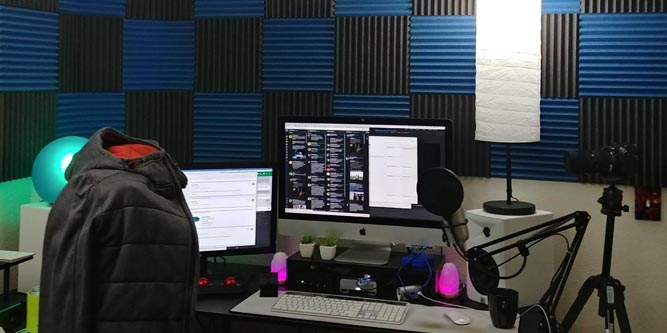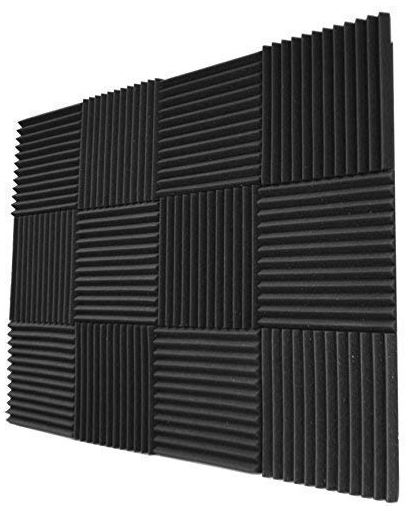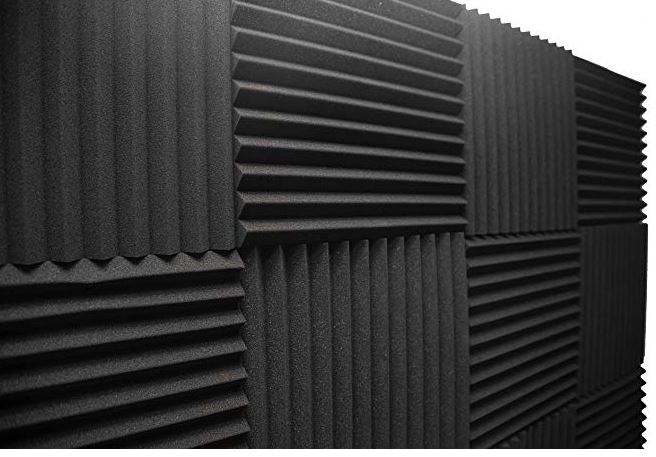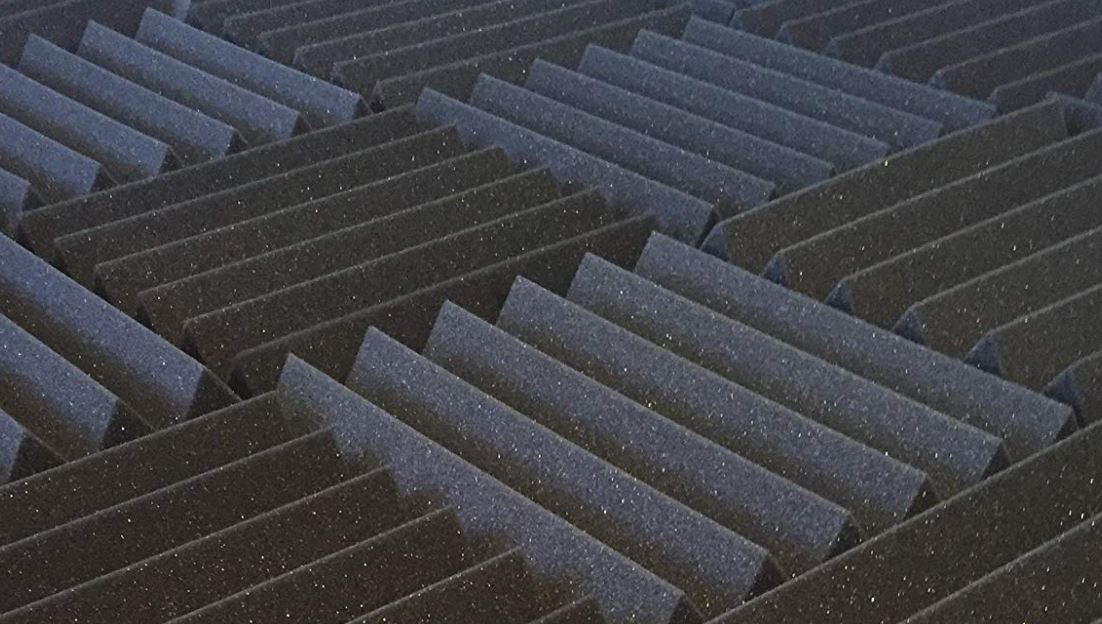If you are new to sound design, you tend to underestimate the importance of good room acoustics. You might go out of your way to get an excellent microphone and some studio monitor headphones, only to end up fairly disappointed in your results. That’s because the acoustics of a room contribute to sound distortion as much as any other piece of equipment involved in recording.
When you’ve got the wrong acoustics in a room, you can spend weeks trying to fix the problem, or partially fix the problem. And with great effort, you can find some innovative work-around solutions. For people who get caught in this trap, the sad irony is that properly fixing room acoustics is usually pretty cheap and simple.
If you clap your hands together inside a recording room, the sound gets projected in every direction. Some sound will head straight to the microphone, but most will strike the various surfaces of a room, and then bounce around the room accordingly. Those waves interact with each other, and augment each other tonally. Eventually, some of those waves can bounce back towards your ear. Worse still, towards the microphone.
Choosing the Best Acoustic Foam Panels
The way you fix this kind of room reverberation problem is with acoustic foam panels. Diffusion panels are often combined with foam panels, allowing the foam to absorb a wider array of tones. But because there’s absolutely nothing intuitive about the physics of sound design, it can be important to pay attention to the details surrounding each acoustic foam panel you consider.
Before launching into each type of panel you might consider, there’s something to get out of the way. You should not confuse soundproofing with an acoustic treatment. An acoustic treatment will not help prevent sound from entering or exiting the room, at least not in any meaningful way.
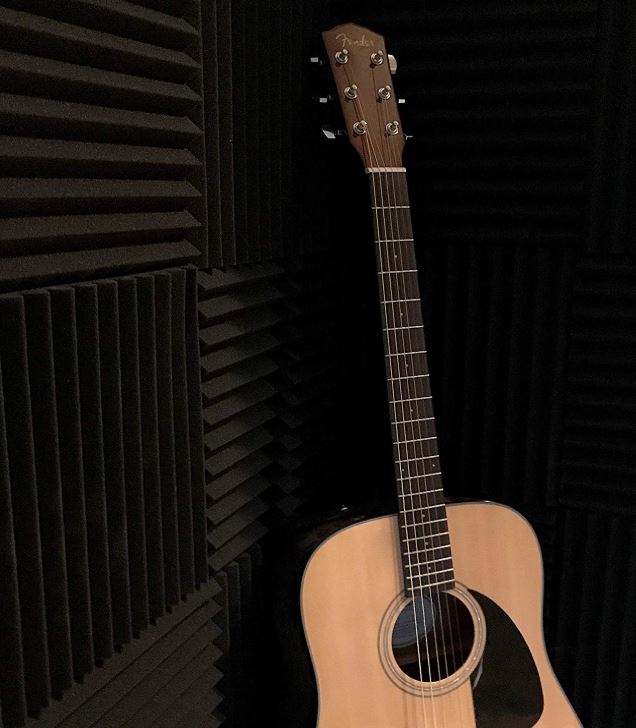
Understanding the Basics
Acoustic treatments will only change the character of sound within a room. If you want soundproofing, you’ll need to block up doors and windows. That’s done with heavy, dense materials that are good at physically blocking and absorbing sound.
You might think one piece of foam is as good as another. It turns out, there’s actually quite of bit of design necessary to make a piece of foam sound good. Even if it were simple, few rooms are exactly alike, which can make it tricky to find the right foam for your specific area.
Wedge Thickness
Because acoustic treatments are altering the character of sound within a room, small changes in the treatment can yield audible differences. For example, consider wedge thickness.
The small triangular wedges that make up acoustic panels are made in several different sizes. The smallest sizes are usually 1” wedges. From a short distance, they look almost flat and smooth. The largest wedges are generally closer to 4” large, which looks like large triangular toy blocks stacked together.
It’s important to keep in mind that bigger isn’t necessarily better. It all depends on what you’re trying to achieve with the panels. What kind of tones are you looking to block? Do you want those tones completely eliminated, or just hushed?
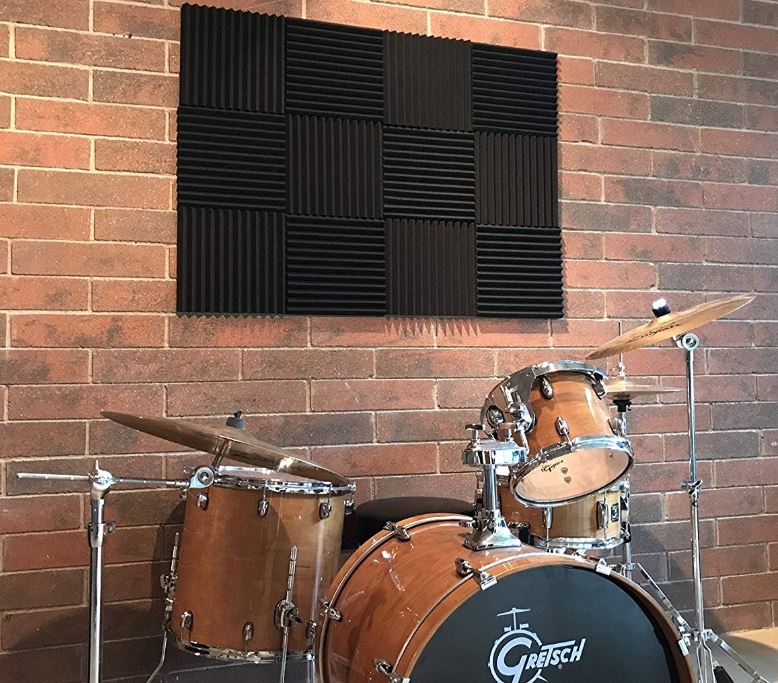
Sound Characteristics
Thinner 1” foam provides excellent bang for your buck. It can cover a great deal of area, making them ideal for people who are recording inside larger spaces. They’ll help cover a lot of area, but are really only effective when total absorption isn’t necessary.
That’s because the smaller wedges are terrible at eliminating bass tones. Larger wedges tend to produce better performance in the treble range as well, but only marginally. It’s really the bass range that’s most affected by wedge size.
Foam Density
What’s the difference between 1” foam wedges, and 1” foam wedges made from a denser material? The audio characteristics between each piece of foam is only subtly different. But denser foam has more absorbing power, and is generally better at eliminating noise.
Unfortunately, foam density isn’t something that’s terribly easy to measure. Consequently, you often end up having to rely on user reviews to determine anything about how dense an acoustic foam panel happens to be.
Foamily Acoustic Studio Panels
If you’re setting up a recording studio in a room dedicated for the task, you might not care about having to put a bunch of unsightly foam on the wall. But when you’re putting the acoustic studio panels in a multi-purpose room, aesthetics matter quite a bit.
Foamily Acoustic Studio Panels are available in charcoal, burgundy, red, ice blue, and olive green. Additionally, you can find packs where half of the foam is made one color, and the other is made from neutral charcoal. Foamily Acoustic Studio Panels have an excellent range of visual options, allowing you to mix and match color patterns to your heart’s content. But these panels can do more than look good.
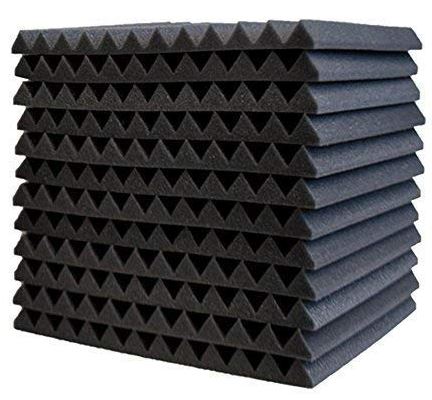
Build & Design
Each tile measures one square foot, with an entire set of twelve panels weighing about twelve ounces. The lightweight nature of each panel makes them really easy to stick them to the wall with improvisation. Their lightweight design also keeps them flexible for use on corners, which is something you might appreciate depending on the shape of your room.
Because these panels are 1” wedges, they make an economical choice for someone who’s trying to cover a large area with a thorough acoustic treatment. But if you’re looking for total deafening within a room, you’ll want thicker wedges than these Foamily Panels can provide. They’re capable of providing a full acoustic treatment, within the confines of their structure.
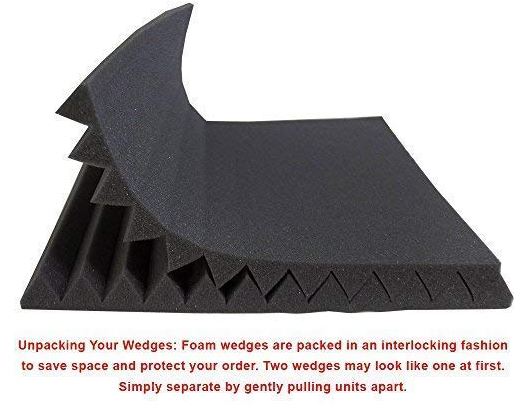
Other Considerations
Foamily Acoustic Studio Panels are available in a 12-pack version, and a 24-pack version. Though confusingly, the larger pack isn’t necessarily more economical. If you end up needing 24 panels or more, you may want to consider two packs of 12.
The wedges are delivered in an interlocking pattern to make them easier for transport. Additionally, wedges are delivered uncompressed. Not compressing the wedges for transportation ensures they arrive in pristine condition. A couple of small tears and wrinkles wouldn’t be fatal to your acoustic treatment. But it could be aesthetically unpleasant, and aesthetics is a good portion of what they bring to the table.
Foamily Acoustic Studio Panels are made in the United States. They’re also constructed with a fire retardant material that won’t turn your recording studio into a tinderbox. Keep in mind panels like this won’t really correct for bass. But if you were getting serious about bass, you’d need bass traps in addition to your panels.
Emerson Studio Acoustics Foam Panels
Like Foamily Acoustic Studio Panels, the Emerson Studio Acoustic Foam Panels are shipped uncompressed. You don’t have to breathe air into your panels to revive them, and with any luck, you don’t have to throw out a bunch of panels that ended up getting wrinkled into oblivion during transport.
Once you’ve got the panels properly positioned, they’re excellent for creating a full acoustic treatment. You might even notice an unusually positive lack of distortion in your recordings. That’s because compared to slightly cheaper panels, these wedges are constructed with slightly denser and thicker foam.
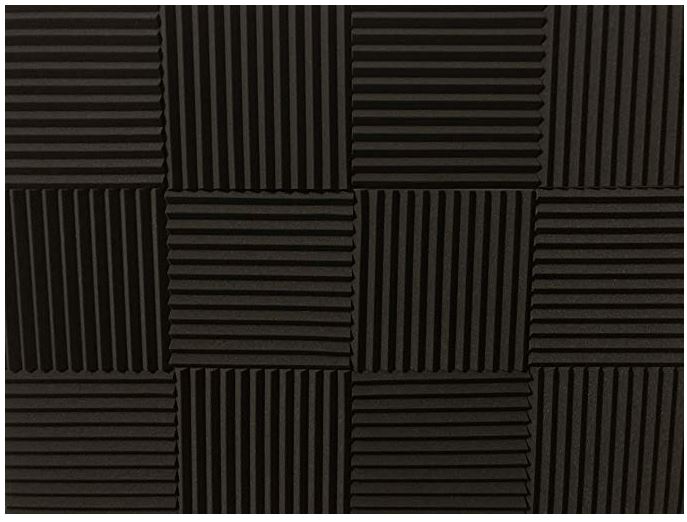
Build & Design
Emerson Studio Acoustics Foam Panels come in a set of four, each measuring one square foot. That’s far fewer panels than you’d get with almost any other manufacturer. Why? Because each piece is incredibly dense, and about 2” thick. In spite of the added thickness, each panel still weighs close to one ounce. And that ensures they don’t become any more difficult to stick to your wall.
Each panel uses the classic wedge design which audio engineers have made for creating an acoustic treatment. That wedge design also makes them a bit simpler to ship, store, or otherwise move about. And of course, it makes them highly effective for reducing sound waves, echoes, and similar residual sounds.
When you take Emerson Studio Acoustic Foam Panels out of their plastic wrapping, they’re initially drenched in a plastic smell. It doesn’t seem like a smell you want to hang up inside your room. But within a few moments the plastic smell will dissipate, and it helps if you have some air circulation to move things along.
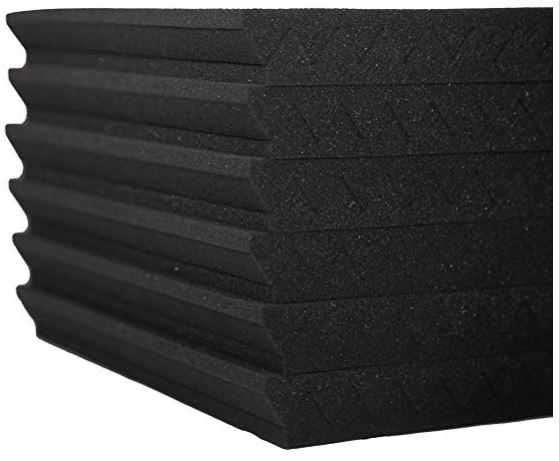
Other Considerations
You really shouldn’t be choosing these acoustic panels unless you’re looking for some of the thickest foam you can find. The difference between this and thinner foam isn’t night and day. In fact, these panels end up weighing almost the exact same as panels which aren’t as dense. Because they’re all incredibly lightweight to begin with.
But this denser does a considerably better job of absorbing certain tones, making it a clearly better choice for those who can afford paying a little extra. Additionally, Emerson Studio Acoustics Foam Panels include a 100% satisfaction guarantee for all orders.
SoundAssured Soundproofing Studio Foam
Bigger wedges can be tough to find. But SoundAssured Soundproofing Studio Foam offers a great solution for people who are looking for effective white noise reduction. Regardless if you’re trying to create a recording studio, or you’re just trying to make the acoustics in your home a little more pleasant, you’ll find no shortage of options from SoundAssured Studio Foam.

Build & Design
Each piece of SoundAssured Soundproofing Studio Foam is almost precisely 2” thick. SoundAssured panels measure one square foot, with a complete kit being composed of eight panels. Each panel uses the classic wedge-tile design, ensuring great sound absorption. And each panel is quite proficient serving as either a permanent or temporary barrier for acoustic energy.
The specific angling of these wedges wasn’t built to create a total deadening of sound, but something closer to a modest hush. These kinds of sound panels are ideal for concert halls, podcast recording, churches, rehearsal halls, home studios, and so forth. Anywhere you’d like better acoustics in a room, without creating a room that sounds totally lifeless.
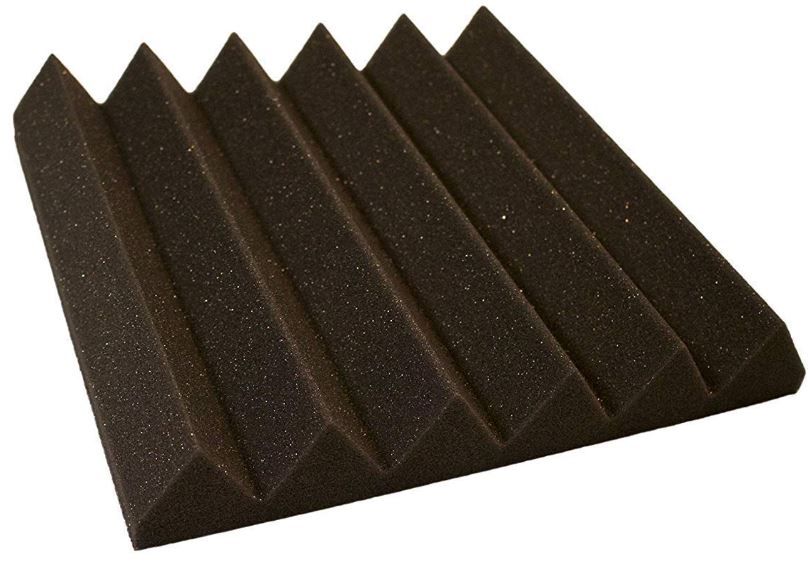
Other Considerations
These foam panels are constructed in the United States, and are built from a self-extinguishing fire retardant material. Though they do not include any foam adhesives, any variety of simple solutions can be used to affix SoundAssured Soundproofing Studio Foam panels to your wall. From general purpose adhesive spray to impaling clips, almost anything that would work on paper can do the trick.
Choosing Between 3 of the Best Acoustic Foam Panels
The most stylistic option on this list are the Foamily Acoustic Studio Panels. You can mix and match about a dozen different color options to perfectly highlight your room. Foamily panels are also the thinnest wedges on this list. Smaller 1” wedges like these are incredibly cost effective, but not very useful for drowning out bass tones.
Emerson Studio Acoustic Foam Panels are incredibly dense. Though they’re also 1” wedges, similar to Foamily Panels, the extra density provides a modestly different acoustic performance. Bass tone coverage isn’t greatly improved, that’s really something you’d need larger wedges to directly address. And something you’d need bass traps to address seriously. But their mid-range and treble range performance is distinctly superior to Foamily.
SoundAssured Soundproofing Studio Foam is a good choice for someone who’s looking for 2” wedges. When it comes to bass tones, they’re far better than any of the other panels on this list. They perform moderately better when it comes to the rest of the tonal range, as well. Though not quite as economical as Foamily panels, they’re among the best solutions for someone who really wants a professional acoustic treatment.
Meet Ry, “TechGuru,” a 36-year-old technology enthusiast with a deep passion for tech innovations. With extensive experience, he specializes in gaming hardware and software, and has expertise in gadgets, custom PCs, and audio.
Besides writing about tech and reviewing new products, he enjoys traveling, hiking, and photography. Committed to keeping up with the latest industry trends, he aims to guide readers in making informed tech decisions.

